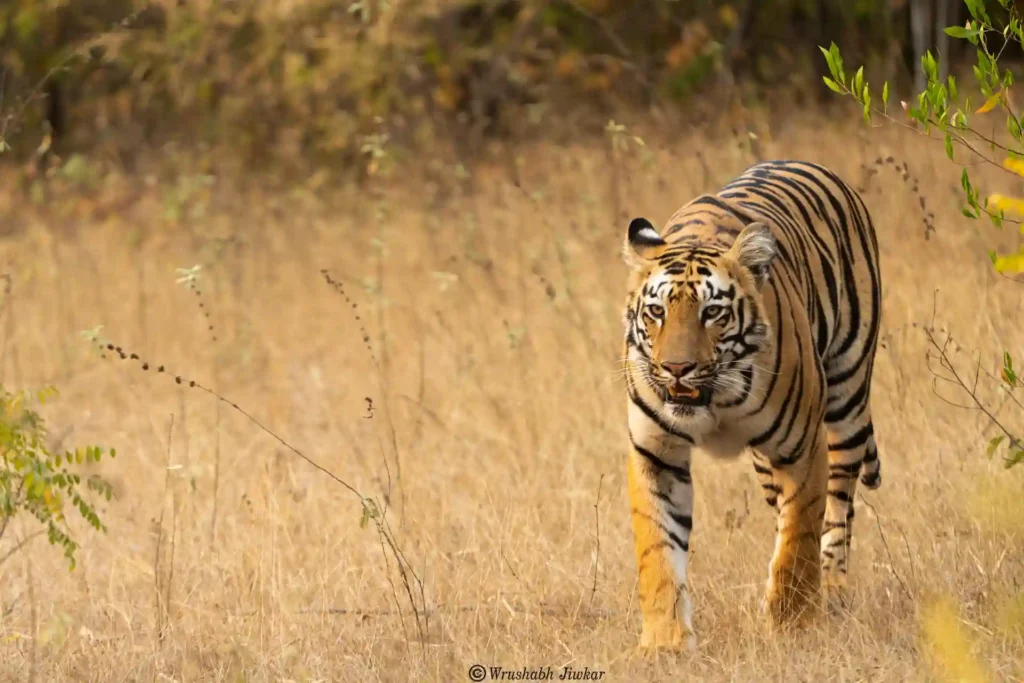
Bandhavgarh NATIONAL PARK
INTRODUCTION
Nestled in the heart of Madhya Pradesh, India, Bandhavgarh National Park is a treasure trove of history and biodiversity. This majestic park, renowned for its dense tiger population, harbors a rich tapestry of historical events that trace back to ancient times. From being the hunting grounds of the Maharajas of Rewa to housing the ancient Bandhavgarh Fort, this national park is not just a haven for wildlife but also a monumental archive of India’s cultural heritage.
The Ancient Beginnings
Bandhavgarh’s history is intertwined with myth and legend, especially from the Ramayana era. It is believed that the fort within the park was built by Lord Rama’s brother, Lakshmana. This mythical connection adds an aura of mystique to the park, making it a site of spiritual significance as well.
The Ramayana Era
According to local lore, the Bandhavgarh Fort was established by Lakshmana, who gifted it to his brother, Lord Rama, to watch over Lanka. The name Bandhavgarh itself means “Brother’s Fort,” signifying its legendary origin.
Post-Independence Era
After India gained independence in 1947, Bandhavgarh underwent significant changes. The region, which was once a royal hunting ground, transformed into a protected national park.
Formation of the National Park
In 1968, Bandhavgarh was officially declared a national park. This move aimed to preserve its rich biodiversity and historical heritage. Today, Bandhavgarh National Park is one of India’s premier wildlife sanctuaries, attracting visitors from around the globe..
Zones in Bandhavgarh National Park
Bandhavgarh National Park is divided into various zones, each offering unique experiences and opportunities to explore its diverse ecosystem.
Core Zone
The core zones are the heart of the park, where the primary wildlife habitats are located. These zones are crucial for conservation efforts and are strictly protected to ensure minimal human interference.
Tala Zone
The Tala Zone is the most famous and frequently visited core zone. Known for its high tiger density, this zone offers the best chances of spotting the elusive big cats. It also houses significant historical sites, including the Bandhavgarh Fort.
Magadhi Zone
The Magadhi Zone, adjacent to the Tala Zone, is another prime area for wildlife sightings. This zone is known for its picturesque landscapes and rich biodiversity, making it a favorite among nature enthusiasts.
Khitauli Zone
The Khitauli Zone is less frequented but equally fascinating. It offers a more tranquil experience with fewer visitors, allowing for a peaceful exploration of the park’s flora and fauna.
Buffer Zone
The buffer zones serve as transitional areas between the core zones and human settlements. These zones are crucial for managing human-wildlife interactions and ensuring the park’s sustainability.
Dhamokhar Zone
The Dhamokhar Zone is a significant buffer area, providing habitat connectivity and supporting various wildlife species. It acts as a protective shield for the core zones.
Johila Zone
The Johila Zone, known for its scenic beauty, features lush forests and water bodies. This zone is a haven for bird watchers and offers a serene environment for wildlife viewing.
Panpatha Zone
The Panpatha Zone, another vital buffer area, is essential for maintaining the ecological balance of the park. It supports diverse flora and fauna and contributes to the overall health of the ecosystem.
Flora in Bandhavgarh National Park
Bandhavgarh’s landscape is a blend of tropical forests, woodlands, and grasslands. The diverse topography includes:
Sal Forests:
These deciduous forests dominate the core areas, providing a lush canopy and essential habitat for many species.
Mixed Forests:
These include trees like dhobin, saj, and tendu, which thrive alongside bamboo thickets.
Grasslands:
The park’s grasslands are vital grazing grounds for herbivores, contributing to the food chain.
Fauna in Bandhavgarh National Park
The park is a haven for wildlife enthusiasts, offering sightings of numerous animal species:
Mammals:
- Tigers: Bandhavgarh is renowned for its significant tiger population.
- Leopards: A healthy breeding population of leopards coexists with the tigers [4].
- Deer Species: Includes sambar, chital, and barking deer.
- Indian Bison (Gaur): These majestic animals roam the park’s grasslands.
- Other Mammals: Sloth bears, wild boars, and Indian foxes add to the park’s diversity.
Birds:
The park is home to over 250 bird species, including the Malabar pied hornbill, crested serpent eagle, and various migratory birds.
Reptiles:
The park houses numerous reptile species such as pythons, cobras, and various lizards.
Visitor Experience
Jungle Safaris
The best way to explore the park’s wildlife, with guided tours available in different zones
Nature Trails
Offering a closer look at the park’s flora and fauna, these guided walks are ideal for nature lovers
BANDHAVGARH FORT
An ancient fort with historical significance, believed to have been built by Lord Rama’s brother Lakshmana during the Ramayana era
How to Get There
By Road
- From Umaria: Bandhavgarh is 37 km from Umaria, about a 1-hour drive.
- From Katni: The park is 100 km from Katni, taking roughly 2 hours by car.
- From Jabalpur: Bandhavgarh is 190 km from Jabalpur, approximately a 4-hour drive.
By Train
- Umaria Station: The nearest railhead, 37 km from the park.
- Katni Station: Another convenient railhead, 100 km away.
- Jabalpur Station: Located 190 km from Bandhavgarh, with good connectivity
By Flight
Jabalpur Airport: The closest airport, 190 km from Bandhavgarh. The drive from the airport to the park takes around 4 hours.
Best Time to Visit
The best time to visit Bandhavgarh National Park is from October to June. Here’s a seasonal breakdown:
- October to March: The weather is pleasant, making it ideal for safaris and wildlife sightings. This period also offers lush greenery post-monsoon.
- April to June: These months are the best for spotting the Royal Bengal Tigers. The vegetation is dry, and the extreme heat draws animals to water sources, increasing the chances of sightings
DETAILED ITINERARY FOR bandhavgarh TOUR
Day 1: Jabalpur to Bandhavgarh
Arrival at Jabalpur -
Arrive at Jabalpur airport at 08:00 hrs and meet our friendly representative. They will assist you with your luggage and ensure a smooth start to your journey.
Journey to Bandhavgarh National Park -
Enjoy the scenic drive from Jabalpur to Bandhavgarh National Park. The 190 km journey takes approximately 4 hours, offering glimpses of rural India and its landscapes.
Checking into the Lodge -
Upon arrival at Bandhavgarh, check into your lodge. The warm hospitality and rustic charm of the lodge make for a perfect retreat after your journey.
Take a moment to absorb the serene surroundings. The lodge is nestled in nature, providing a tranquil atmosphere ideal for wildlife enthusiasts.
Afternoon Safari -
After a delicious lunch at the lodge, gear up for your first adventure: an afternoon Jeep safari in Bandhavgarh National Park.
Evening at the Lodge -
After an exhilarating safari, return to the lodge for a delicious dinner. The meals here are prepared with fresh, local ingredients, offering a taste of regional cuisine.
Spend the night in the comfort of your lodge, surrounded by the sounds of the jungle. It’s a perfect end to an exciting day.
Day 2: Morning and Afternoon Safaris
Morning Safari -
Start your day with an early morning Jeep safari. The crisp morning air and the possibility of spotting wildlife make it an exhilarating experience.
Bandhavgarh is renowned for its rich biodiversity. The park is home to a variety of wildlife, offering ample opportunities for sightings.
Bandhavgarh boasts a high tiger density. Keep your eyes peeled for these majestic creatures during your safari.
Apart from tigers, you may encounter leopards, sloth bears, Indian bison, and many other species. Each sighting adds to the excitement of the safari.
Lunch at the Resort -
Return to the resort for a hearty lunch. Share your morning adventures with fellow guests and exchange stories
Afternoon Safari -
The afternoon safari provides another chance to explore different parts of the park. Each safari is a unique journey with new surprises.
Bandhavgarh is a paradise for birdwatchers, with over 200 species. Look out for the crested serpent eagle, honey buzzard, and the elusive paradise flycatcher.
Bring a pair of binoculars and a bird guidebook. Early mornings and late afternoons are the best times for birdwatching in the park.
Day 3: Final Safari and Departure
Morning Jeep Safari -
The final morning safari is a poignant experience. Every sight and sound feels precious as you prepare to bid farewell to Kanha.
Return to Jabalpur -
Embark on your final Jeep safari in the park. Make the most of this last opportunity to immerse yourself in the wild.
After the morning safari, return to the lodge for breakfast. Then, drive back to Jabalpur airport to catch your flight home or to your next destination.
Tour Inclusion
-
Accomodotion in Tadoba on Double Sharing Basis with all Meals
-
04 Exclusive Gypsy Safari
-
All Safari Permit Charges & Gypsy Charges Included
-
Expert Guide & Driver
-
Assistance Throughout Tour
-
All Land Transfer in Air Conditioned Innova / Crysta / Ertiga
Tour Exclusion
-
Transfer from home to home
-
Lens and camera charges.
-
Mobile Phone is Ban in Tadoba
-
Any personal orders and laundry services.
-
Alcoholic beverages and package drinking water
-
Special orders for food by the client
FAQ'S
for BANDHAVGARH Tour
The best time to visit is between October and June, with peak wildlife sightings from April to June.
Comfortable clothing, sturdy shoes, a hat, sunscreen, binoculars, and a camera are essential for a safari.
Yes, safaris are safe when conducted with experienced guides and following park regulations.
A minimum of 2-3 days is recommended to fully explore Bandhavgarh National Park and experience multiple safaris.
GUEST TESTIMONILAS
With 100% genuine reviews, you can read them here or on Google Maps.



